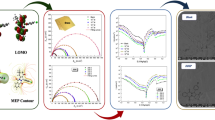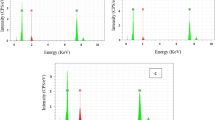Abstract
The electrochemical behaviours of a brass alloy in 0.1 M nitric acid, including the hyamine inhibitor with concentrations between 2.5 × 10−4 M and 1.0 × 10−5 M, were studied. For this purpose, potentiodynamic polarisation, electrochemical impedance spectroscopy (EIS), linear polarisation resistance (LPR) techniques, and flame atomic absorption spectroscopy (FAAS) were utilised. The inhibitor molecules adsorbed on the brass surface were calculated to be in good agreement with the Langmuir adsorption isotherm and the standard free enthalpy of adsorption (ΔG ∘ads ). Hyamine effectively improved the corrosion inhibition of brass and acted as a mixed-type inhibitor on alloy surfaces. The surface morphology of the alloy was also clarified by optical microscopic and SEM techniques. A theoretical study of the corrosion inhibition efficiency of hyamine molecule was carried out using density functional theory (DFT) at the B3LYP/6-311G(d,p) basis set level.
Similar content being viewed by others
References
Abboud, Y., Abourriche, A., Saffaj, T., Berrada, M., Charrouf, M., Bennamara, A., & Hannache, H. (2009). A novel azo dye, 8-quinolinol-5-azoantipyrine as corrosion inhibitor for mild steel in acidic media. Desalination, 237, 175–189. DOI:10.1016/j.desal.2007.12.031.
Abdallah, M., Al-Agez, M., & Fouda, A. S. (2009). Phenylhydrazone derivatives as corrosion inhibitors for -α-brass in hydrochloric acid solutions. International Journal of Electrochemical Science, 4, 336–352.
Abd El Meguid, E. A., & Awad, N. K. (2009). Electrochemical pitting corrosion behaviour of α-brass in LiBr containing solutions. Corrosion Science, 51, 1134–1139. DOI: 10.1016/j.corsci.2009.02.019.
Abed, Y., Kissi, M., Hammouti, B., Taleb, M., & Kertit, S. (2004). Peptidic compound as corrosion inhibitor for brass in nitric acid solution. Progress in Organic Coatings, 50, 144–147. DOI:10.1016/j.porgcoat.2004.02.001.
Ahamad, I., Prasad, R., & Quraishi, M. A. (2010). Adsorption and inhibitive properties of some new Mannich bases of Isatin derivatives on corrosion of mild steel in acidic media. Corrosion Science, 52, 1472–1481. DOI:10.1016/j.corsci.2010.01.015.
Alfantazi, A. M., Ahmed, T. M., & Tromans, D. (2009). Corrosion behavior of copper alloys in chloride media. Materials & Design, 30, 2425–2430. DOI:10.1016/j.matdes.2008.10.015.
Aljourani, J., Raeissi, K., & Golozar, M. A. (2009). Benzimidazole and its derivatives as corrosion inhibitors for mild steel in 1M HCl solution. Corrosion Science, 51, 1836–1843. DOI:10.1016/j.corsci.2009.05.011.
Aljourani, J., Golozar, M. A., & Raeissi, K. (2010). The inhibition of carbon steel corrosion in hydrochloric and sulfuric acid media using some benzimidazole derivatives. Materials Chemistry and Physics, 121, 320–325. DOI: 10.1016/j.matchemphys.2010.01.040.
Allam, N. K. (2007). Thermodynamic and quantum chemistry characterization of the adsorption of triazole derivatives during Muntz corrosion in acidic and neutral solutions. Applied Surface Science, 253, 4570–4577. DOI:10.1016/j.apsusc.2006.10.008.
Asefi, D., Arami, M., & Mahmoodi, N. M. (2010). Electrochemical effect of cationic gemini surfactant and halide salts on corrosion inhibition of low carbon steel in acid medium. Corrosion Science, 52, 794–800. DOI:10.1016/j.corsci.2009.10.039.
Bayol, E., Kayakırılmaz, K., & Erbil, M. (2007). The inhibitive effect of hexamethylenetetramine on the acid corrosion of steel. Materials Chemistry and Physics, 104, 74–82. DOI:10.1016/j.matchemphys.2007.02.073.
Bayol, E., Gürten, T., Gürten, A. A., & Erbil, M. (2008). Interactions of some Schiff base compounds with mild steel surface in hydrochloric acid solution. Materials Chemistry and Physics, 112, 624–630. DOI:10.1016/j.matchemphys.2008.06.012.
Becke, A. D. (1993). Density-functional thermochemistry. III. The role of exact exchange. The Journal of Chemical Physics, 98, 5648–5652. DOI: 10.1063/1.464913.
Behpour, M., Ghoreishi, S. M., Soltani, N., & Salavati-Niasari, M. (2009). The inhibitive effect of some bis-N,S-bidentate Schiff bases on corrosion behaviour of 304 stainless steel in hydrochloric acid solution. Corrosion Science, 51, 1073–1082. DOI:10.1016/j.corsci.2009.02.011.
Elayyachy, M., Elkodadi, M., Aouniti, A., Ramdani, A., Hammouti, B., Malek, F., & Elidrissi, A. (2005). New bipyrazole derivatives as corrosion inhibitors for steel in hydrochloric acid solutions. Materials Chemistry and Physics, 93, 281–285. DOI:10.1016/j.matchemphys.2005.03.059.
Erbil, M. (1988). The determination of corrosion rates by analysis of AC impedance diagrams. Chimica Acta Turcica, 1, 59–70.
Fontana, M. G., & Greene, N. D. (1967). Corrosion engineering (pp. 270). New York, NY, USA: McGraw-Hill.
Frisch, M. J., Trucks, G. W., Schlegel, H. B., Scuseria, G. E., Robb, M. A., Cheeseman, J. R., Scalmani, G., Barone, V., Mennucci, B., Petersson, G. A., Nakatsuji, H., Caricato, M., Li, X., Hratchian, H. P., Izmaylov, A. F., Bloino, J., Zheng, G., Sonnenberg, J. L., Hada, M., Ehara, M., Toyota, K., Fukuda, R., Hasegawa, J., Ishida, M., Nakajima, T., Honda, Y., Kitao, O., Nakai, H., Vreven, T., Montgomery, J. A., Jr., Peralta, J. E., Ogliaro, F., Bearpark, M., Heyd, J. J., Brothers, E., Kudin, K. N., Staroverov, V. N., Kobayashi, R., Normand, J., Raghavachari, K., Rendell, A., Burant, J. C., Iyengar, S. S., Tomasi, J., Cossi, M., Rega, N., Millam, J. M., Klene, M., Knox, J. E., Cross, J. B., Bakken, V., Adamo, C., Jaramillo, J., Gomperts, R., Stratmann, R. E., Yazyev, O., Austin, A. J., Cammi, R., Pomelli, C., Ochterski, J. W., Martin, R. L., Morokuma, K., Zakrzewski, V. G., Voth, G. A., Salvador, P., Dannenberg, J. J., Dapprich, S., Daniels, A. D., Farkas, Ö., Foresman, J. B., Ortiz, J. V., Cioslowski, J., & Fox, D. J. (2009). Gaussian 09, Revision A.1 [computer software]. Wallingford, CT, USA: Gaussian.
Fuchs-Godec, R. (2006). The adsorption, CMC determination and corrosion inhibition of some N-alkyl quaternary ammonium salts on carbon steel surface in 2 M H2SO4. Colloids and Surfaces A: Physicochemical and Engineering Aspects, 280, 130–139. DOI:10.1016/j.colsurfa.2006.01.046.
Fuchs-Godec, R. (2007). Inhibitory effect of non-ionic surfactants of the TRITON-X series on the corrosion of carbon steel in sulphuric acid. Electrochimica Acta, 52, 4974–4981. DOI:10.1016/j.electacta.2007.01.075.
Gao, G., & Liang, C. H. (2007). 1,3-Bis-diethylamino-propan-2-ol as volatile corrosion inhibitor for brass. Corrosion Science, 49, 3479–3493. DOI:10.1016/j.corsci.2007.03.030.
Herrag, L., Hammouti, B., Elkadiri, S., Aouniti, A., Jama, C., Vezin, H., & Bentiss, F. (2010). Adsorption properties and inhibition of mild steel corrosion in hydrochloric solution by some newly synthesized diamine derivatives: Experimental and theoretical investigations. Corrosion Science, 52, 3042–3051. DOI:10.1016/j.corsci.2010.05.024.
Horton, R. M. (1970). New metallographic evidence for dezincification of brass by redisposition of copper. Corrosion, 26, 160–163.
Kılınççeker, G. (2008). The effects of acetate ions on electrochemical behaviour of brass in chloride solutions. Colloids and Surfaces A: Physicochemical and Engineering Aspects, 329, 112–118. DOI:10.1016/j.colsurfa.2008.07.002.
Langenegger, E. E., & Robinson, F. P. A. (1968). Effect of the polarization technique on dezincification rates and the physical structure of dezincified zones. Corrosion-NACE, 24, 411–417.
Langenegger, E. E., & Robinson, F. P. A. (1969). A study of the mechanism of dezincification of brasses. Corrosion-NACE, 25, 59–66.
Li, X. H., Deng, S. D., Fu, H., & Li, T. H. (2009). Adsorption and inhibition effect of 6-benzylaminopurine on cold rolled steel in 1.0 M HCl. Electrochimica Acta, 54, 4089–4098. DOI:10.1016/j.electacta.2009.02.084.
Mahmoud, S. S. (2007). Corrosion inhibition of Cu-Fe alloys in HCl solutions by amphoteric surfactants. Corrosão e Protecção de Materiais, 26, 53–60.
Mihit, M., El Issami, S., Bouklah, M., Bazzi, L., Hammouti, B., Addi, E. A., Salghi, R., & Kertit, S. (2006). The inhibited effect of some tetrazolic compounds towards the corrosion of brass in nitric acid solution. Applied Surface Science, 252, 2389–2395. DOI:10.1016/j.apsusc.2005.04.009.
Milošev, I., Mikić, T. K., & Gaberšček, M. (2006). The effect of Cu-rich sub-layer on the increased corrosion resistance of Cu-xZn alloys in chloride containing borate buffer. Electrochimica Acta, 52, 415–426. DOI:10.1016/j.electacta.2006.05.024.
Obot, I. B., Obi-Egbedi, N. O., & Umoren, S. A. (2009). The synergistic inhibitive effect and some quantum chemical parameters of 2,3-diaminonaphthalene and iodide ions on the hydrochloric acid corrosion of aluminium. Corrosion Science, 51, 276–282. DOI:10.1016/j.corsci.2008.11.013.
Özkır, D., & Bayol, E. (2011). Inhibition efficiency of benzidine for mild steel in acidic media. Protection of Metals and Physical Chemistry of Surfaces, 47, 517–527. DOI:10.1134/s2070205111040150.
Özkır, D., Kayakırılmaz, K., Bayol, E., Gürten, A. A., & Kandemirli, F. (2012). The inhibition effect of Azure A on mild steel in 1 M HCl. A complete study: Adsorption, temperature, duration and quantum chemical aspects. Corrosion Science, 56, 143–152. DOI:10.1016/j.corsci.2011.11.010.
Pchelnikov, A. P., Sitnikov, A. D., Marshakov, I. K., & Losev, V. V. (1981). A study of the kinetics and mechanism of brass dezincification by radiotracer and electrochemical methods. Electrochimica Acta, 26, 591–600. DOI: 10.1016/0013-4686(81)80025-4.
Pickering, H.W. (1970). Formation of new phases during anodic dissolution of Zn-rich Cu-Zn alloys. Journal of the Electrochemical Society, 117, 8–15. DOI: 10.1149/1.2407450.
Pickering, H. W., & Wagner, C. (1967). Electrolytic dissolution of binary alloy containing a noble metal. Journal of the Electrochemical Society, 114, 698–706. DOI: 10.1149/1.2426709.
Pickering, H. W., & Byrne, P. J. (1971). On preferential anodic dissolution of alloys in the low-current region and the nature of the critical potential. Journal of the Electrochemical Society, 118, 209–215. DOI: 10.1149/1.2407969.
Polunin, A. V., Pchelnikov, A. P., Losev, V. V., & Marshakov, I. K. (1982). Electrochemical studies of the kinetics and mechanism of brass dezincification. Electrochimica Acta, 27, 467–475. DOI: 10.1016/0013-4686(82)85025-1.
Ramji, K., Cairns, D. R., & Rajeswari, S. (2008). Synergistic inhibition effect of 2-mercaptobenzothiazole and Tween-80 on the corrosion of brass in NaCl solution. Applied Surface Science, 254, 4483–4493. DOI:10.1016/j.apsusc.2008.01.031.
Ranjana, Maji, M., & Nandi, M. M. (2009). Corrosion inhibition of brass in presence of sulphonamidoimidazoline and hydropyrimidine in chloride solution. Indian Journal of Chemical Technology, 16, 221–227.
Ravichandran, R., & Rajendran, N. (2005a). Influence of benzotriazole derivatives on the dezincification of 65-35 brass in sodium chloride. Applied Surface Science, 239, 182–192. DOI:10.1016/j.apsusc.2004.05.145.
Ravichandran, R., & Rajendran, N. (2005b). Electrochemical behaviour of brass in artificial seawater: effect of organic inhibitors. Applied Surface Science, 241, 449–458. DOI:10.1016/j.apsusc.2004.07.046.
Robinson, F. P. A., & Shalit, M. (1964). The dezincification of brass. Anti-Corrosion Methods and Materials, 11(4), 11–14. DOI:10.1108/eb020168.
Solmaz, R., Karda, G., Çulha, M., Yazıcı, B., & Erbil, M. (2008a). Investigation of adsorption and inhibitive effect of 2-mercaptothiazoline on corrosion of mild steel in hydrochloric acid media. Electrochimica Acta, 53, 5941–5952. DOI:10.1016/j.electacta.2008.03.055.
Solmaz, R., Karda, G., Yazıcı, B., & Erbil, M. (2008b). Adsorption and corrosion inhibitive properties of 2-amino-5-mercapto-1,3,4-thiadiazole on mild steel in hydrochloric acid media. Colloids and Surfaces A: Physicochemical and Engineering Aspects, 312, 7–17. DOI:10.1016/j.colsurfa.2007.06.035.
Solmaz, R., Altunbaş, E., & Kardaş, G. (2011). Adsorption and corrosion inhibition effect of 2-((5-mercapto-1,3,4-thiadiazol-2-ylimino)methyl)phenol Schiff base on mild steel. Materials Chemistry and Physics, 125, 796–801 DOI:10.1016/j.matchemphys.2010.09.056.
Sugawara, H., & Ebiko, H. (1967). Dezincification of brass. Corrosion Science, 7, 513–523. DOI: 10.1016/s0010-938x(67)80090-8.
Sürme, Y., Gürten, A. A., & Bayol, E. (2011). Corrosion behaviour of mild steel in presence of scale inhibitor in sulfuric acid solution. Protection of Metals and Physical Chemistry of Surfaces, 47, 117–120. DOI:10.1134/s2070205110051053.
Uhlig, H. H. (1963). Corrosion and corrosion control: An introductionzto corrosion science and engineering (pp. 290). New York, NY, USA: Wiley.
Wang, X. M., Yang, H. Y., & Wang, F. H. (2010). A cationic gemini-surfactant as effective inhibitor for mild steel in HCl solutions. Corrosion Science, 52, 1268–1276. DOI:10.1016/j.corsci.2009.12.018.
Young, D. C. (2001). Computational chemistry: A practical guide for applying techniques to real world problems. New York, NY, USA: Wiley.
Zhang, R., & Somasundaran, P. (2006). Advances in adsorption of surfactants and their mixtures at solid/solution interfaces. Advances in Colloid and Interface Science, 123–126, 213–229. DOI:10.1016/j.cis.2006.07.004.
Zhang, Q., Gao, Z. N., Xu, F., & Zou, X. (2011). Adsorption and corrosion inhibitive properties of gemini surfactants in the series of hexanediyl-1,6-bis-(diethyl alkyl ammonium bromide) on aluminium in hydrochloric acid solution. Colloids and Surfaces A: Physicochemical and Engineering Aspects, 380, 191–200. DOI:10.1016/j.colsurfa.2011.02.035.
Author information
Authors and Affiliations
Corresponding author
Rights and permissions
About this article
Cite this article
Özkır, D., Bayol, E., Gürten, A.A. et al. Effect of hyamine on electrochemical behaviour of brass alloy in HNO3 solution. Chem. Pap. 67, 202–212 (2013). https://doi.org/10.2478/s11696-012-0255-y
Received:
Revised:
Accepted:
Published:
Issue Date:
DOI: https://doi.org/10.2478/s11696-012-0255-y




